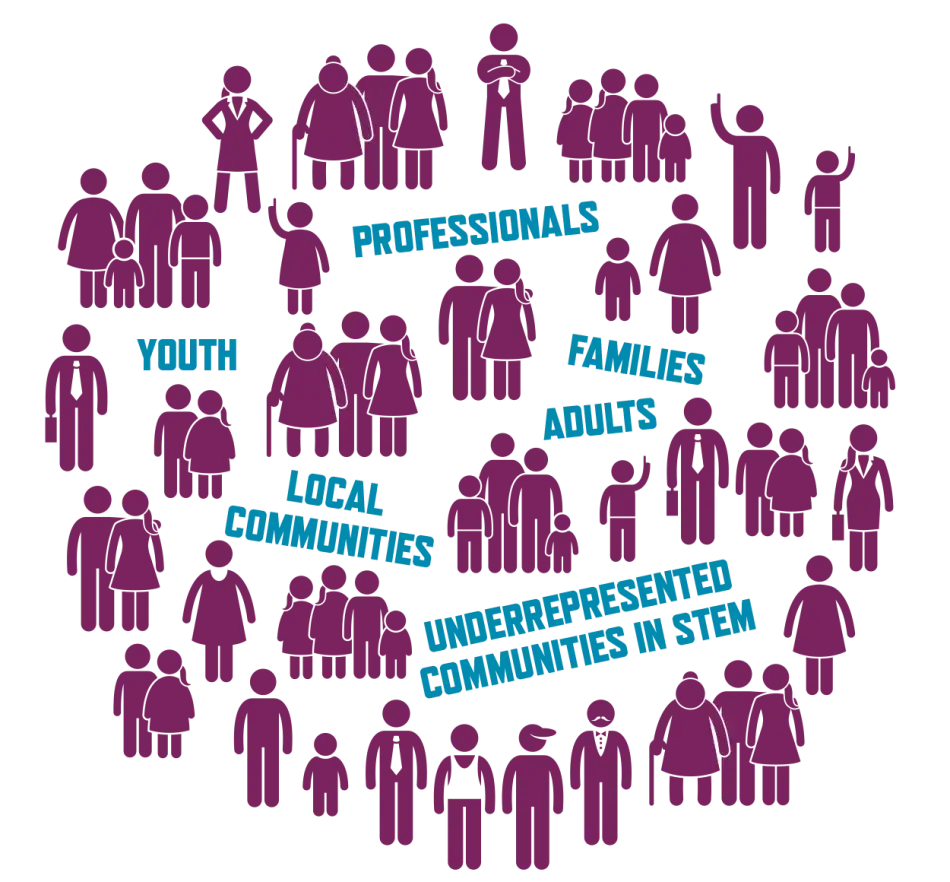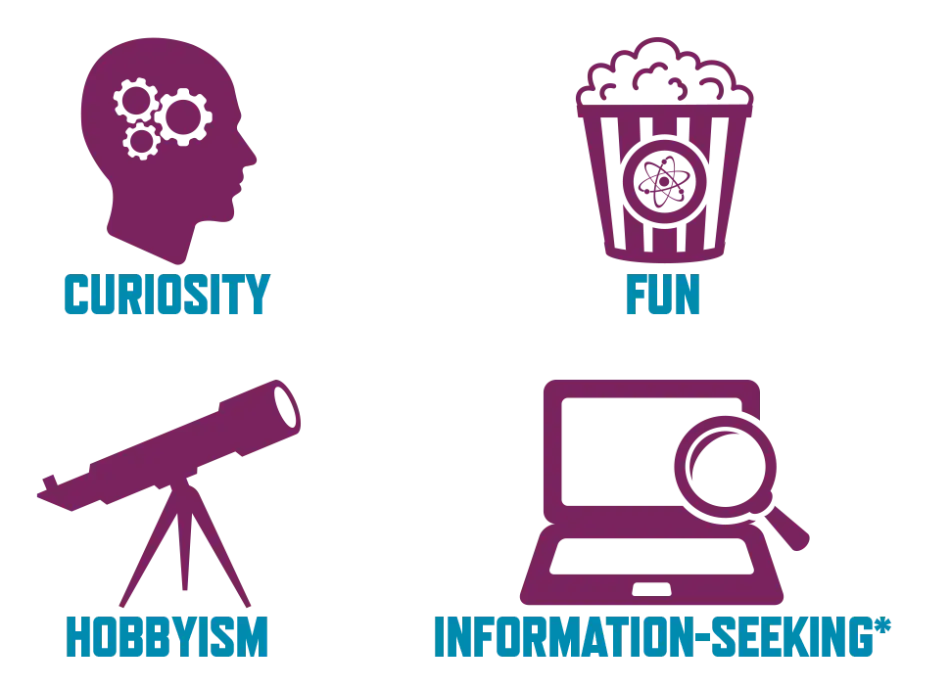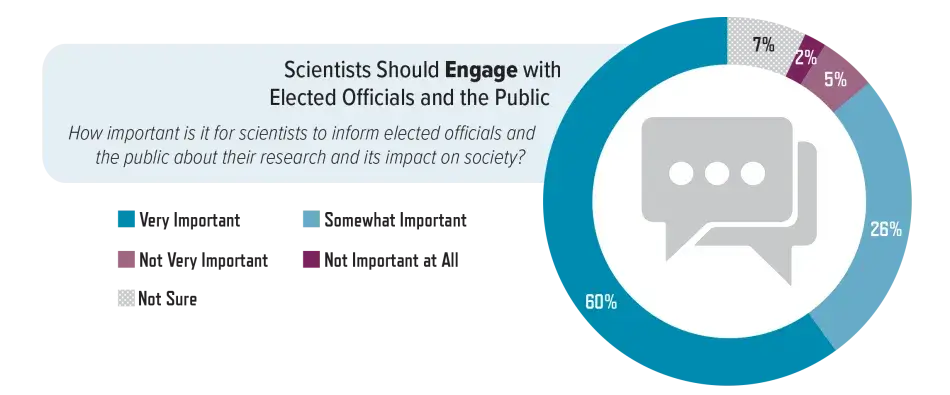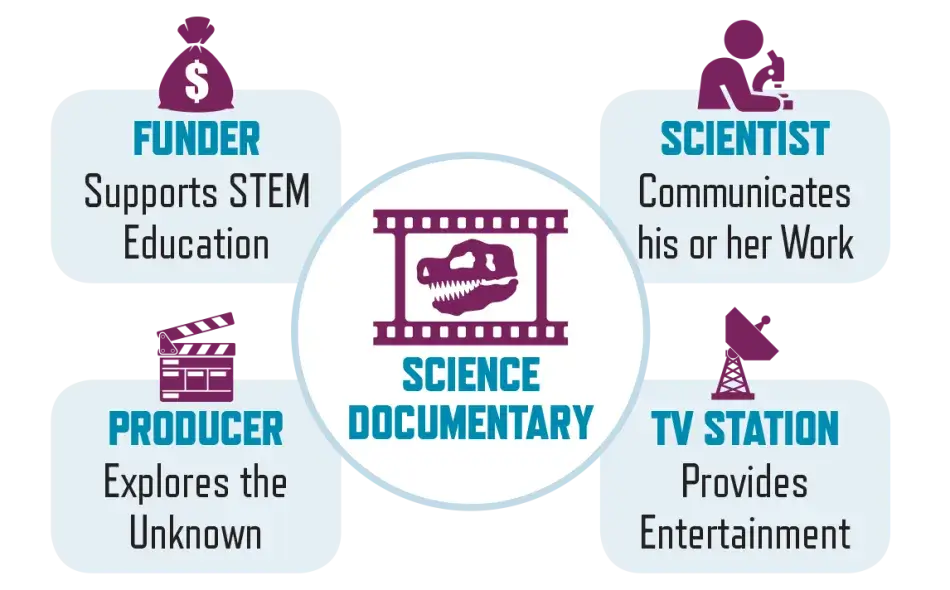Section 1: Building a Conceptual Framework
Science Communication and Engagement: To What End?
This section examines three core elements of science communication and engagement: 1) the diverse categories of participants; 2) the range of motivations that lead each of these groups to participate; and 3) the resulting outcomes, including but not limited to the acquisition of new skills, knowledge, attitudes, or behaviors. The following pages focus on the motivations of, and outcomes for, participants from the public and scientific communities. Despite the heterogeneity within these groups (particularly the public; see next page), there are nevertheless common themes regarding the nuances of their motivations and outcomes. It is necessary to understand these considerations in order to develop effective approaches to science communication and engagement and to evaluate their outcomes.

Overview of the Participants
The participants in science communication and engagement encompass several major categories, such as supporting institutions, professional practitioners (including scientific experts), and the public. The motivations of these communities influence their approach to science communication and engagement as well as their goals and outcomes. The categorization given below is not an exhaustive list, and not all of these participant groups are involved in every type of activity. For example, translating science into evidence-based policy may involve additional groups, such as policy-makers and/or advocacy organizations, and engagement on social media does not necessarily require institutional support mechanisms.
Supporting Institutions
Institutions can provide access to critical resources, from financial and logistical support to the personnel or infrastructure that make science communication and engagement possible. These participants have a significant role in defining the outcomes and potential impact. Supporting institutions include but are not limited to:

Professional Practitioners
Each of the following categories of professionals may possess expertise in science communication, engagement, pedagogy, or, in the case of scientists, a specific subject matter. Moreover, scientists who gain experience and training in science communication and engagement techniques may assume dual roles, becoming facilitators, writers, or producers in addition to content experts. Professional practitioners can include:

"The Public"
There is no singular “public,” but rather many publics whose diverse backgrounds, expertise, and experiences can influence the efficacy of science communication and engagement (see Takeaways about the “Public” below).* The term public is used here to differentiate general science communication and engagement from more-specialized activities such as communicating about science-based policy, or the day-to-day teaching of science in classrooms. Insights into which members of the public are likely to participate in a given activity can be gained through published research and surveys on participation in similar activities. In addition, science communication and engagement efforts may be designed to reach particular categories of the public, for example:

* Note that the “public” can include scientists, who are members of the general public when participating in activities outside of their field of expertise but generally have more knowledge of the scientific process than the average participant.
Takeaways about the “Public” from Perceptions of Science in America:
- Confidence in science varies based on age, race, educational attainment, region, political ideology, and other factors.
- Attitudes toward science are not uniformly associated with one particular demographic group but instead vary based on the specific science issue.
- Recent research suggests that underlying factors such as group identity can strongly influence perceptions about science.9
Motivations for Communicating and Engaging
Effective science communication and engagement requires an understanding of what motivates each group of participants to become involved. In many cases, it is not necessary for participants to be motivated by the same objectives, as long as the objectives are compatible. Consider, for example, a citizen science project in which amateur astronomers are trained by scientific experts to submit star observations. The project supports the hobby of amateur astronomers while establishing a new database for scientists interested in furthering their scientific research. Without additional engagement, however, the project might be less effective in stimulating broad public support for government funding for astronomical research.
For Public Participants, Motivations for Engaging with Science Might Include:
Personal
Self-motivations can include anything from a person’s concern about rising sea levels, to curiosity about local wildlife, to desire to have an enjoyable experience. Examples of personal concerns and motivations include:

* Such as about medical issues or climate change impacts.
Social
Social motivations are based on concern for others or an interest in shared experiences, such as participating in a community event, sharing an experience with a friend, or providing scientific opportunities to children. These could involve:

Professional
Professional motivations include seeking out scientific content that is directly or indirectly related to one’s career.10

Translating Concept into Practice
Studies show that visitors to zoos and aquariums are particularly diverse in age, prior knowledge, and interests.11 Heterogeneous groups of visitors can, however, share common motivations, such as information-seeking or an interest in the social experience of their co-attendees.12 As a result, exhibitions at these institutions are generally designed to appeal to a broad cross section of the public.
Scientists Have a Variety of Personal and Professional Motivations
A 2013 survey of Ph.D.-level university scientists in the United States found that “defending science” and “informing the public about science” were high priorities for online public engagement13. Other personal motivations included the desire to improve science literacy, the desire to strengthen the perception of science, and personal enjoyment.14 Participation in communication and engagement activities may also be motivated by funding or job requirements or the desire to increase the visibility of one’s personal research. Public demand supports these motivations: a 2017 Research!America survey found that 86 percent of people agreed it was “very” or “somewhat” important for scientists to inform elected officials and the public about their research and its impact.

Source: Research!America, America Speaks: Poll Data Summary, Vol. 17 (Arlington, Va.: Research!America, 2017); and Research!America, Public Perception of Clinical Trials (Arlington, Va.: Research!America, 2017).
One Activity, Many Motivations
The experts and institutions who organize, facilitate, host, fund, and/or contribute to science communication and engagement activities have diverse and sometimes conflicting motivations. The following example demonstrates how the motivations of funders, producers, scientists, and disseminators can converge as part of a shared activity. In this example, all the participants share the goal of developing a science documentary series, but have distinct motivations for their involvement and seek different outcomes.

Outcomes of Science Communication and Engagement
Communication and engagement activities can have different outcomes for each of the involved participants. Potential outcomes range from changes in attitude, knowledge, or skills, to a greater curiosity and excitement about science, to better institutional relationships with the local community. For example, a scientist who participates in a science café may develop a greater understanding of the local community’s perspective on his or her work, whereas an attendee may become more motivated to click on a news article or watch a YouTube video on that scientific topic. Such outcomes can be immediate and carry direct personal benefits. (For examples of broader societal benefits, see Section 3: Designing Engagement for Specific Impact.)
Categories of Personal Outcomes
- Interest (such as greater curiosity in science, including scientific careers)
- Knowledge and Skills (such as improved understanding of the scientific process or skill in
communicating science) - Behavior (such as greater capacity for informed decision-making)
- Motivation (such as increased likelihood of participating in additional activities)15

Evaluation of Outcomes
The social sciences use formal evaluations to assess the outcomes of science communication and engagement activities, but evaluations can be time-consuming and costly and can require additional expertise. Evaluations commonly focus on immediate outcomes, such as a participant’s enjoyment or increased interest in a topic. Regardless of the method used, the assessment goals should align with the motivations and desired outcomes of the engagement activity. Evaluation methods include:16

* Surveys are the most common.
Understanding Cumulative Impact
An individual’s underlying attitudes toward science are the result of the interaction between an unknown number of experiences with science and prior knowledge about science17. The long-term, cumulative impacts of experiences and engagement with science are challenging to assess because these experiences do not occur as isolated events and there is limited data on an individual’s movement between activities. Further, differences in metrics and methodologies limit researchers’ ability to compare existing evaluation data.

ADVANCING EVALUATION: Databases such as informalscience.org/evaluation, maintained by the Center for the Advancement of Informal Science Education, are useful for identifying established assessment tools. The Center for Public Engagement with Science at AAAS (www.aaas.org/pes) advocates for the development of new scales for evaluating outcomes, such as measuring scientists’ self-efficacy and outcome expectations.18
Highlight: Science Capital Model
The “science capital” model is one example of a comprehensive framework that has been developed to help design activities for a specific long-term outcome. The ASPIRES project, supported by the United Kingdom’s Economic and Social Research Council, found that “STEM participation issues are not simply the result of students’ not liking science enough.”19 From this study, the concept of science capital was used as a holistic framing device for science engagement focused on boosting perceptions that science is “for me” in people over sixteen years of age. The study identified seven key dimensions of science capital as influencing a young person’s attitudes toward science:
- Science literacy
- Science-related attitudes, values, and dispositions
- Science media consumption
- Participation in out-of-school learning
- Family science skills and knowledge
- Knowing people in science-related roles
- Talking about science in everyday life20
Discussion
A core conceptual framework of components that inform the outcomes of science communication and engagement is necessary for having an expanded, interdisciplinary conversation about building the capacity for these activities. Specifically, a shared understanding of the types of participants and the range of sometimes conflicting motivations will further the development of mutually beneficial communication and engagement experiences.
These efforts run parallel to those of organizations such as the Center for Public Engagement with Science and Technology at the American Association for the Advancement of Science, which has developed a “theory of change” for achieving long-term impacts from public engagement activities (see Resources on Science Engagement below). Ongoing efforts to assess outcomes at science museums, festivals, and other science engagement venues should be supported. Additional social science research is necessary to understand the relationships between these experiences with science in order to identify the activities that support continued participation and build impact. The lessons from such programs must be shared widely among the many communities that contribute to the landscape of science communication and engagement.
As the field develops, it should be recognized that the value of outcomes such as increased curiosity, excitement, and understanding of science, as they relate to changes in behavior and attitudes toward science, are not fully understood. Therefore, outcomes that do not have an immediately visible linear connection to broader societal goals, such as building trust in science about a controversial topic, should not be immediately dismissed. While more research is required, recent data suggest that interest in science and curiosity about science for personal pleasure may produce agreement with the scientific consensus on global warming or support for science funding.21
Resources on Science Engagement
Theory of Change for Public Engagement with Science (2016)
A summary and overview of the American Association for the Advancement of Science vision for engagement that supports long-term, aggregate impact. This theory includes a “logic model for public engagement with science.”22
CAISE’s Year in ISE Review (most recently, 2018)
An annual report of notable publications, events, and trends in the informal STEM education community. It includes resources related to making and tinkering, citizen science, media, cyber learning and gaming, public science events, and more.23
Learning Science in Informal Environments: People, Places, and Pursuits (2009)
A consensus report from the National Academies of Sciences, Engineering, and Medicine that presents a comprehensive analysis of learning environments and types of learners.24
Many Experts, Many Audiences: Public Engagement with Science and Informal Science Education (2009)
A CAISE inquiry report examining how public engagement with science contributes to science education.25
Public Engagement Research and Major Approaches (2015)
An annotated bibliography of science engagement literature, commissioned by the American Association for the Advancement of Science Alan I. Leshner Leadership Institute for Public Engagement with Science.26
Public Engagement with Science: A Guide to Creating Conversations among Publics and Scientists for Mutual Learning and Societal Decision-Making (2017)
“A guide to creating conversations among publics and scientists for mutual learning and societal decision-making” from the Museum of Science in Boston. The guide includes key questions for planning, designing, and evaluating engagement activities, with examples and descriptions of concepts throughout.27
Typology for Public Engagement with Science: A Conceptual Framework for Public Engagement Involving Scientists (2016)
A conceptual framework for public engagement with science from the Center for Research on Lifelong STEM Learning at Oregon State University. The typology provides an overview of the key elements of science engagement and example opportunities targeted toward scientists and practitioners.28